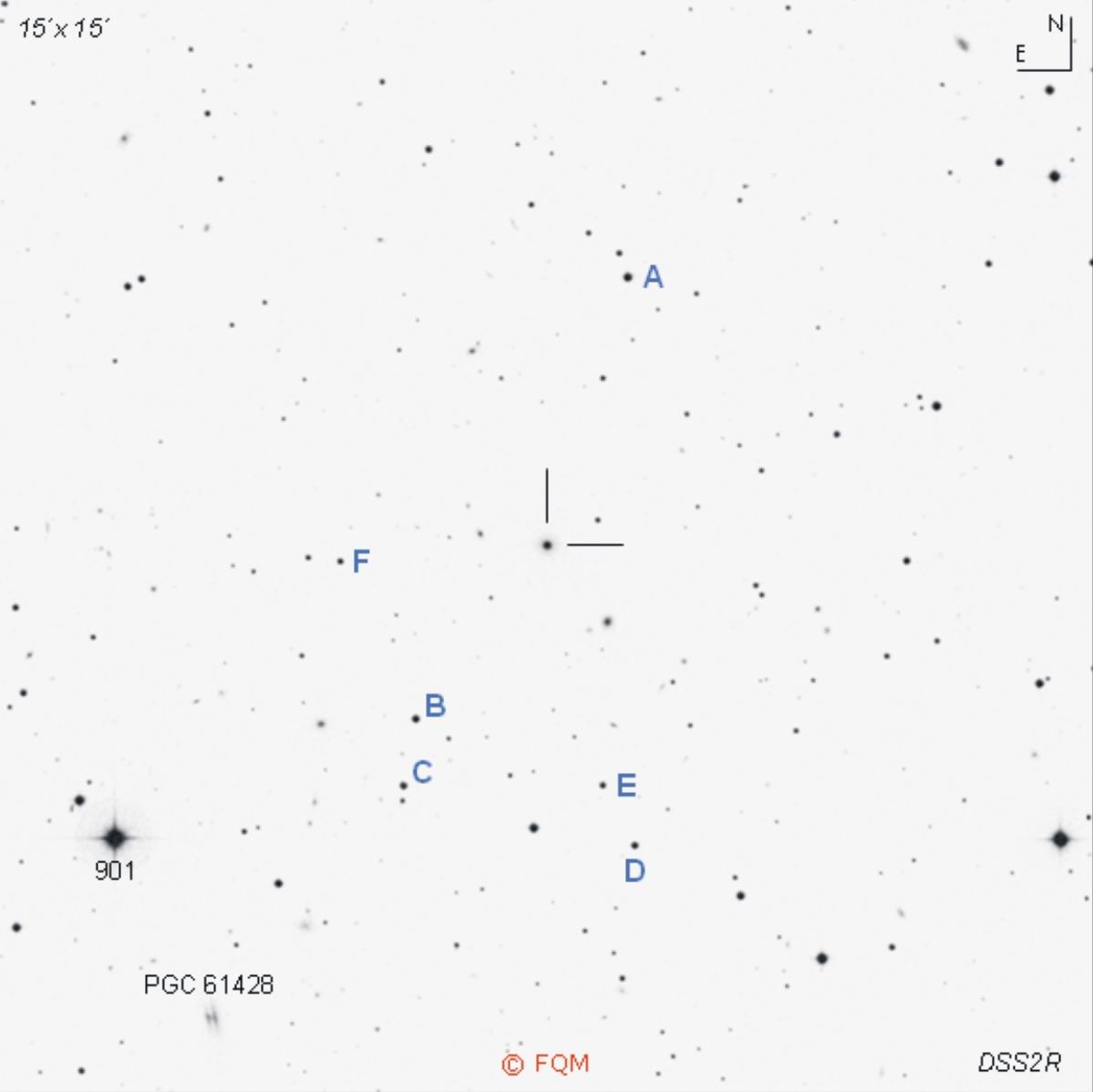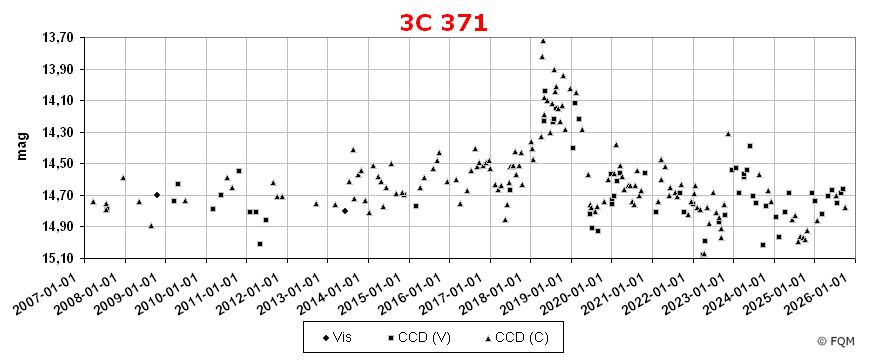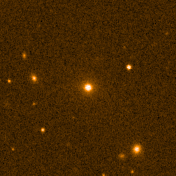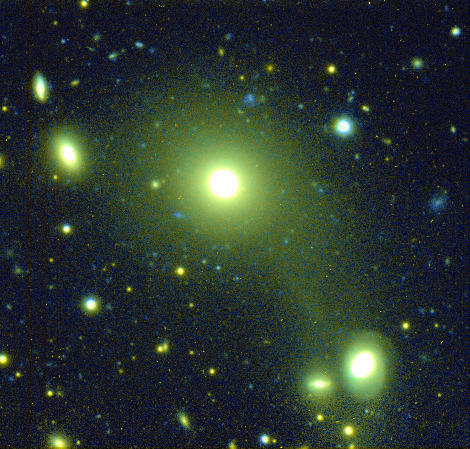
| Frankfurt Quasar Monitoring |
| 3C 371 |
| Cross-Identifications | 3C 371.0, VII Zw 768, ZWG 340.35, UGC 11130 KAZ 273, NRAO 548, MCG +12-17-000, PGC 61417 CGCG 1807.2+6949, 7C 180717.90+694858.00 WMAP J1806+6949, HS 1807+6948, TXS 1807+698 IRAS 18072+6949, 2MASX J18065063+6949275 1807+698, GB6 J1806+6949, RX J1806.8+6949 87GB 180718.0+694904, 4C 69.24, S4 1807+69 QSO B1807+698, H 1801+698, 1ES 1807+698 1H 1803+696, 1RXS J180650.2+694923 |
| Equat. coordinates | RA 18 06 50.7 DE +69 49 28 (J2000) |
| Constellation | Draco |
| Type | BL Lac |
| Redshift | z=0.051 (2) / z=0.052 (4) |
| Distance (2) (5) |
206 Mpc |
| Total mag range (mv) (3) | 13.5 - 15.4 |
| Catalog Magnitude (1) | 14.22 |
| Absolute Magnitude (1) | -22.6 MB |
| Light Travel-Time (2) | 0.656 × 109 yrs |

Comparison stars
| star | U | B | V |
| A | 14.64 | 14.20 | 13.60 |
| B | 15.93 | 15.08 | 14.21 |
| C | 15.44 | 15.13 | 14.53 |
| D | 15.52 | 15.26 | 14.67 |
| E | 16.75 | 15.97 | 15.11 |
| F | 16.71 | 16.06 | 15.42 |

 Credit:
DSS2B, ESO / Size
3´× 3´
3C 371 appears as a star-like object with adiffuse halo (phot. diam. 15"×15"), together with other faint galaxies [N up, E left]. |
 Credit: K.
Nilsson, NOT / Size 176" × 159"
This B-/R-band composite image shows a tidal tailconnecting the host of 3C 371 to a pair of companion galaxies in the lower right corner. |
| 3C
371 is a
variable BL Lacertae object in Draco, about 1.8° SE of 4.2-mag Phi
Draconis (43 Dra), and only 1.5° E of bright galaxy NGC 6503. This
object was discovered in 1959 as a radio source by the 3. Cambridge
Radio Survey (3C). In 1966, a compact galaxy of mag 14.4
(phot.) was identified as
the optical counterpart. This compact
galaxy was discovered just
one year earlier by Fritz Zwicky
(Zw), who described it as
a "large blue spherical compact".
The determination of the redshift of this system was only possible by
spectroscopic investigations of the stellar population of the host
galaxy (UGC), as the bright galaxy core (AGN) revealed only a
featureless spectrum. Together with its optical variability and its
high degree of polarization,
3C 371 was classified as a BL Lacertae object in 1975. Besides its
nature as a strong
radio source, 3C
371 has also been known as a source of both infrared and X-ray
emissions. 3C
371 can
be best described as a variable BL Lac object at the centre
of
a giant elliptical, which resides in a compact group of other
galaxies. The
elliptical host of 3C 371 has an impressive true
size of approximately 300×260 klyrs. Direct imaging showed that the
host galaxy of 3C 371 is
an
interacting
system with a tidal tail directing towards the closest two neighbouring
systems (see high resolution image above). 3C 371 is a variable object with a total range of about 2 magnitudes in the optical. At maximum, visual observers need at least an 8- to 10-inch telescope to glimpse this stellar object. In large instruments, 3C:371 becomes increasingly star-like with a very faint outer halo. CCD observers, as well as visual observers, shall use the comparison stars given above. Another sequence was published by the AAVSO. ____________
Two deep sky showpieces in the vicinity of 3C 371 are worth visiting: First there is NGC 6503, a bright galaxy only 1.5° to the west. NGC 6503 is a large and elongated galaxy at a distance of some 16 million light-years. The second object is located some 3° to the south. There we find the showpiece planetary NGC 6543, also known as the "Cat´s Eye Nebula". NGC 6543 is rich in details and one of the brightest objects of its class. Stargazers who like to observe more very old quasi-stellar photons may turn to quasar PGC 61965, a bright 14-mag object at a distance of about 1.5×109 light-years, only 3.8° NNE of 3C 371. CCD observers may also take a look at S4 1749+70, a violently variable BL Lac object at a whopping distance of about 6.5×109 light-years, only 1.6° W of 3C 371, and only 4´ SW of NGC 6503. |
| Arp, H., Visvanathan, N. 1970, ApL, 5, 73; Compact Companions Connected to 3C 371. Cruz-Gonzales, I., Huchra, J.P. 1984, AJ, 89, 441; Continuum distributions of a x-ray observed sample of BL Lac Objects. Karge, S.; Helle Quasare für 8- bis 10-Zoll Teleskope. Ein Beobachtungsführer zur visuellen Beobachtung von Quasaren und BL Lacertae Objekten; Frankfurt 2005. Katajainen, S., Takalo, L.O., et al. 2000, A&AS, 143, 357; Tuorla Quasar Monitoring I. Observations of 1995-1997. Kinman, T.D. 1976, ApJ, 205, 1; Photoelectric Magnitudes and Polarization Data for possible BL Lacertae Objects. Lawrence, C.R., Zucker, C.R., et al. 1996, ApJS, 107, 541; Optical Spectra of a Complete Sample of Radio Sources. I. The Spectra. Lloyd, C. 1984, MNRAS, 209, 697; Optical monitoring of radio sources. Martel, A.R., Baum, S.A., Sparks, W.B., et al. 1999, ApJS, 122, 81M; Hubble Space Telescope Snapshot Survey of 3CR Radio Source Counterparts. III. Radio Galaxies with z<0.1. McGimsey, B.Q., Miller, H.R. 1977, AJ, 82, 7; Photoelectric comparison sequences in the fields of optically active extragalactic objects. Miller, J. 1975, ApJ, 200, L55; The Composite Nature of the N Galaxy 3C 371. Nilsson, K., et al. 1997, ApJ, 484, L107; Discovery of an optical jet in the BL Lacertae object 3C 371. Oke, J.B. 1967, ApJ, 150, L5; Optical variations in the radio galaxy 3C 371. Pearson, T.J., Perley, R.A., Readhead, A.C.S. 1985, AJ, 90, 738; Compact radio sources in the 3C catalog. Pollock, J.T., Pica, A.J., et al. 1979, AJ, 84, 11; Long-term optical variations of 20 violently variable extragalactic radio sources. Sandage, A. 1967, ApJ, 150, L9; Additional data on the optical variations in 3C 371 and other properties of N-type galaxies. Scarpa, R., Urry, C.M., et al. 1999, ApJ, 526, 643; Hubble Space Telescope Observations of the optical jets of PKS 0521-365, 3C 371, and PKS 2201+044. Selmes, R., Tritton, K., Wordsworth, R. 1975, MNRAS, 170, 15; Optical monitoring of radio sources-IV. Results up to 1973 April. Steinicke, W.; Beobachtungsliste für helle Quasare; Umkirch 1999. Stickel, M., Fried, J.W., Kühr, H. 1993, A&AS, 98, 393; The complete sample of 1 Jy BL Lac objects. II - Observational data. Ulvestad, J.S., Johnston, K.J. 1984, AJ, 89, 189; A search for arcminute-scale radio emission in BL Lacertae objects. Véron-Cetty, M.-P., Véron, P. 2001, A&A 374, 92; A Catalogue of Quasars and Active Nuclei: 10th edition. Véron-Cetty, M.-P., Véron, P. 2003, A&A 412, 399; A Catalogue of Quasars and Active Nuclei: 11th edition. Véron-Cetty, M.-P., Véron, P. 2006, A&A 455, 776; A Catalogue of Quasars and Active Nuclei: 12th edition. Véron-Cetty, M.-P., Véron, P. 2010, A&A 518, 10; A Catalogue of Quasars and Active Nuclei: 13th edition. Webb, J.R., Smith, A.G., et al. 1988, AJ, 95, 374; Optical Observations of 22 violently variable extragalactic sources: 1968-1986. Wenzel, K. 1997, Interstellarum 10, 25; Quasare - Objekte für den beobachtenden Amateur. Wenzel, K. 1996, Interstellarum 8, 7; 3C 371 - Visuelle Quasarbeobachtung. Wyndham, J. 1966, ApJ, 144, 459; Optical Identification of Radio Sources in the 3C Revised Catalogue. |
| Links: Hamburg Quasar Monitoring AAVSO |